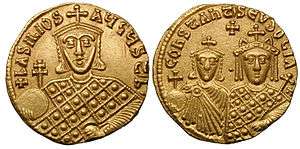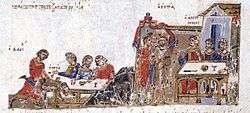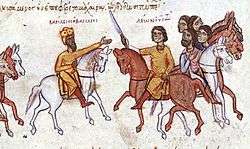Basil I
Basil I, called the Macedonian (Greek: Βασίλειος ὁ Μακεδών, Basíleios ō Makedṓn; 811 – August 29, 886), was a Byzantine Emperor who reigned from 867 to 886. Born a simple peasant in the theme of Macedonia, he rose in the Imperial court. He entered into the service of Theophilitzes, a relative of Emperor Michael III (r. 842–867), and was given a fortune by the wealthy Danielis. He gained the favour of Michael III, whose mistress he married on the emperor's orders, and was proclaimed co-emperor in 866. He ordered the assassination of Michael the next year. Despite his humble origins, he showed great ability in running the affairs of state. He was the founder of the Macedonian dynasty. He was succeeded upon his death by his son (perhaps actually Michael III's son) Leo VI.
| Basil I | |
|---|---|
| Emperor and Autocrat of the Romans | |
 Basil, his son Constantine, and his second wife, Empress Eudokia Ingerina | |
| Emperor of the Byzantine Empire | |
| Reign | 867–886 |
| Predecessor | Michael III |
| Successor | Leo VI the Wise |
| Born | 811 Macedonia |
| Died | August 29, 886 (aged 75) |
| Consort | Eudokia Ingerina |
| Wives |
|
| Issue Detail | Emperor Leo VI (paternity uncertain) Emperor Alexander III Patriarch Stephen I (paternity uncertain) |
| Dynasty | Macedonian dynasty |
From peasant to emperor
Basil was born to peasant parents in late 811 (or sometime in the 830s in the estimation of some scholars) at Chariopolis in the Byzantine theme of Macedonia (an administrative division corresponding to the area of Adrianople in Thrace).[1][2] The name of his father was Bardas, the name of his grandfather was Maïktes, his mother was named Pankalo (Παγκαλώ), and her father was called Leo.[3] His ethnic origin is unknown, and has been a subject of debate. During Basil's reign, an elaborate genealogy was produced that purported that his ancestors were not mere peasants, as everyone believed, but descendants of the Arsacid (Arshakuni) kings of Armenia, and also of Constantine the Great.[4][5] The Armenian historians Samuel of Ani and Stephen of Taron record that he hailed from the village of Thil in Taron.[3] In contrast, Persian writers such as Hamza al-Isfahani,[6] or al-Tabari, call both Basil and his mother Saqlabi, an ethnogeographic term that usually denoted the Slavs, but can also be interpreted as a generic term encompassing the inhabitants of the region between Constantinople and Bulgaria.[7] Claims have therefore been made for an Armenian,[8] Slavic,[6][9] or indeed "Armeno-Slavonic"[2] origin for Basil I. The name of his mother points to a Greek origin on the maternal side.[7] The general scholarly consensus is that Basil's father was "probably" of Armenian origin, and settled in Byzantine Thrace.[3] The author of the only dedicated biography of Basil I in English has concluded that it is impossible to be certain what the ethnic origins of the emperor were, though Basil was definitely reliant on the support of Armenians in prominent positions within the Byzantine Empire.[10]

One story asserts that he had spent a part of his childhood in captivity in Bulgaria, where his family had, allegedly, been carried off as captives of the Khan Krum (r. 803–814) in 813. Basil lived there until 836, when he and several others escaped to Byzantine-held territory in Thrace.[1] Basil was ultimately lucky enough to enter the service of Theophilitzes, a relative of the Caesar Bardas (the uncle of Emperor Michael III), as a groom. While serving Theophilitzes, he visited the city of Patras, where he gained the favour of Danielis, a wealthy woman who took him into her household and endowed him with a fortune.[11] He also earned the notice of Michael III by his abilities as a horse tamer and in winning a victory over a Bulgarian champion in a wrestling match; he soon became the Byzantine Emperor's companion, confidant, and bodyguard (parakoimomenos).[12] Symeon Magister describes Basil as "... most outstanding in bodily form and heavy set; his eyebrows grew together, he had large eyes and a broad chest, and a rather downcast expression".[13]

On Emperor Michael's orders, Basil divorced his wife Maria and married Eudokia Ingerina, Michael's favourite mistress, in around 865.[11] During an expedition against the Arabs, Basil convinced Michael III that his uncle Bardas coveted the Byzantine throne, and subsequently murdered Bardas with Michael's approval on April 21, 866. Basil then became the leading personality at court and was invested in the now vacant dignity of kaisar (caesar), before being crowned co-emperor on May 26, 866. This promotion may have included Basil's adoption by Michael III, himself a much younger man. It was commonly believed that Leo VI, Basil's successor and reputed son, was really the son of Michael.[11] Although Basil seems to have shared this belief (and hated Leo), the subsequent promotion of Basil to caesar and then co-emperor provided the child with a legitimate and Imperial parent and secured his succession to the Byzantine throne. When Leo was born, Michael III celebrated the event with public chariot races, whilst he pointedly instructed Basil not to presume on his new position as junior emperor.[14]
When Michael III started to favour another courtier, Basiliskianos, Basil decided that his position was being undermined. Michael threatened to invest Basiliskianos with the Imperial title and this induced Basil to pre-empt events by organizing the assassination of Michael on the night of September 23/24, 867. Michael and Basiliskianos were insensibly drunk following a banquet at the palace of Anthimos when Basil, with a small group of companions (including his father Bardas, brother Marinos, and cousin Ayleon),[note 1] gained entry. The locks to the chamber doors had been tampered with and the chamberlain had not posted guards; both victims were then put to the sword.[note 2] On Michael III's death, Basil, as an already acclaimed co-emperor, automatically became the ruling basileus.[18]
Reign
Basil I became an effective and respected monarch, ruling for 19 years, despite being a man with no formal education and little military or administrative experience. Moreover, he had been the boon companion of a debauched monarch and had achieved power through a series of calculated murders. That there was little political reaction to the murder of Michael III is probably due to his unpopularity with the bureaucrats of Constantinople because of his disinterest in the administrative duties of the Imperial office. Also, Michael's public displays of impiety had alienated the Byzantine populace in general. Once in power Basil soon showed that he intended to rule effectively and as early as his coronation he displayed an overt religiosity by formally dedicating his crown to Christ. He maintained a reputation for conventional piety and orthodoxy throughout his reign.[19]
_from_the_Chronikon_of_Ioannis_Skylitzes.jpg)
Domestic policies
Because of the great legislative work which Basil I undertook, he is often called the "second Justinian." Basil's laws were collected in the Basilika, consisting of sixty books, and smaller legal manuals known as the Eisagoge. Leo VI was responsible for completing these legal works. The Basilika remained the law of the Byzantine Empire down to its conquest by the Ottomans. Ironically, this codification of laws seems to have begun under the direction of the caesar Bardas who was murdered by Basil.[20] Basil personally oversaw the construction of the Nea Ekklesia cathedral.[21][22] His ecclesiastical policy was marked by good relations with Rome. One of his first acts was to exile the Patriarch of Constantinople, Photios, and restore his rival Ignatios, whose claims were supported by Pope Adrian II.[1]
Foreign affairs
Emperor Basil's reign was marked by the troublesome ongoing war with the heretical Paulicians, centered on Tephrike on the upper Euphrates, who rebelled, allied with the Arabs, and raided as far as Nicaea, sacking Ephesus. Basil's general, Christopher, defeated the Paulicians in 872, and the death of their leader, Chrysocheir, led to the definite subjection of their state.[23] Basil was the first Byzantine emperor since Constans II (r. 641–668) to pursue an active policy to restore the Empire's power in the West. Basil allied with Holy Roman Emperor Louis II (r. 850–875) against the Arabs and sent a fleet of 139 ships to clear the Adriatic Sea of their raids. With Byzantine help, Louis II captured Bari from the Arabs in 871. The city eventually became Byzantine territory in 876. However, the Byzantine position on Sicily deteriorated, and Syracuse fell to the Emirate of Sicily in 878. This was ultimately Basil's fault as he had diverted a relief fleet from Sicily to haul marble for a church instead. Although most of Sicily was lost, the general Nikephoros Phokas (the Elder) succeeded in taking Taranto and much of Calabria in 880. The successes in the Italian peninsula opened a new period of Byzantine domination there. Above all, the Byzantines were beginning to establish a strong presence in the Mediterranean Sea, and especially the Adriatic.[24]
Last years and succession

Basil's spirits declined in 879, when his eldest and favorite son Constantine died. Basil now raised his youngest son, Alexander, to the rank of co-emperor. Basil disliked the bookish Leo, on occasion physically beating him; he probably suspected Leo of being the son of Michael III. In his later years, Basil's relationship with Leo was clouded by the suspicion that the latter might wish to avenge the murder of Michael III. Leo was eventually imprisoned by Basil after the detection of a suspected plot, but the imprisonment resulted in public rioting; Basil threatened to blind Leo but was dissuaded by Patriarch Photios. Leo was eventually released after the passage of three years.[25] Basil died on August 29, 886, from a fever contracted after a serious hunting accident when his belt was caught in the antlers of a deer, and he was allegedly dragged 16 miles through the woods. He was saved by an attendant who cut him loose with a knife, but he suspected the attendant of trying to assassinate him and had the man executed shortly before he himself died.[26] One of the first acts of Leo VI as ruling emperor was to rebury, with great ceremony, the remains of Michael III in the Imperial Mausoleum within the Church of the Holy Apostles in Constantinople. This did much to confirm in public opinion the view that Leo considered himself to have been Michael's son.[27]
Family
Aspects of the family relationships of Basil I are uncertain and open to a variety of interpretations. Therefore, the information given below should not be treated as comprehensive or definite:[28]
- By his first wife Maria, Basil I had several children, including:
- Bardas.
- Anastasia, who married the general Christopher.
- Constantine (circa 865 – September 3, 879), co-emperor to Basil from January 6, 868, to his death. According to George Alexandrovič Ostrogorsky, Constantine was betrothed to Ermengard of Provence, daughter of Holy Roman Emperor Louis II and Engelberga in 869. The marital contract was broken in 871 when relations between Basil and Louis broke down.
- By Eudokia Ingerina, Basil I officially had the following children:
- Leo VI, who succeeded as Byzantine emperor and may actually have been a son of Michael III.
- Stephen I, Patriarch of Constantinople, who may also actually have been a son of Michael III.
- Alexander, who succeeded as Byzantine emperor in 912.
- Anna Porphyrogenita, a nun at the convent of St. Euphemia in Petrion.
- Helena Porphyrogenita, a nun at the convent of St. Euphemia in Petrion.
- Maria Porphyrogenita, a mother of nuns at the convent of St. Euphemia in Petrion.
Leo VI's son Constantine VII wrote a biography of his grandfather, the Vita Basilii, around 950.[29]
In popular culture
- Harry Turtledove, a historian noted for his speculative fiction based on alternative history, has written several series set in a place called Videssos, which is a thinly disguised Byzantine Empire. The Tale of Krispos trilogy – Krispos Rising (1991), Krispos of Videssos (1991), and Krispos the Emperor (1994) – are fictionalized tellings of the rise of Basil and his sons.[30]
- Stephen Lawhead's book, Byzantium (1996), uses the succession of Basil I as seed for the conspiracy which occupies most of the novel.[31]
- Robert Greene's book The 48 Laws of Power (1998), features Basil I's rise to power, by way of his interactions and later his manipulations of Michael III, as an example of a "transgression of the law" for Law #2, "Never put too much trust in friends, learn how to use enemies".[32]
See also
Notes
- The name of the father of Basil is unrecorded; however, Byzantine naming conventions are sometimes used to predict that of a relative. The names of Basil's male siblings and other relatives are recorded from later in his reign.[15][16]
- A man named John of Chaldia killed Michael III, cutting off both the Emperor's hands before returning to stab him in the heart.[17]
References
Citations
- Treadgold 1997, p. 455.
- Vasiliev 1928–1935, p. 301.
- PmbZ, Basileios I. (#832/add. corr.).
- Treadgold 1997, p. 457.
- Vogt & Hausherr 1932, p. 44.
- Tobias 2007, p. 20.
- PmbZ, Pankalo (#5679).
- Treadgold 1997, p. 455.
- Finlay 1853, p. 213.
- Tobias 2007, p. 264.
- Bury 1911.
- Gregory 2010, p. 242.
- Head, pp. 231–232.
- Treadgold 1997, p. 453.
- Tougher, p. 26.
- Herlong, M. (1987) Kinship and social mobility in Byzantium, 717–959, Catholic University of America, pp. 76–77.
- Finlay 1853, pp. 180–181
- Treadgold 1997, pp. 453–455.
- Finlay 1853, pp. 214–215.
- Finlay 1853, pp. 221–226.
- Mango 1986, p. 194.
- Magdalino 1987, p. 51.
- Jenkins 1987, p. 191.
- Jenkins 1987, pp. 185–187.
- Jenkins 1987, pp. 196–197.
- Treadgold 1997, p. 461.
- Finlay 1853, p. 241.
- Tougher, pp. 7–8, 30–31, 42–50
- Kazhdan & Cutler 1991.
- Turtledove, Harry (25 July 2006). "Introduction". In Martin, George R. R.; Dick, Philip K.; McCaffrey, Anne (eds.). The Best Military Science Fiction of the 20th Century: Stories. Random House Publishing Group. p. xii. ISBN 9780345494290. Retrieved 27 August 2018.
- "BYZANTIUM by Stephen R. Lawhead". Kirkus Reviews. 15 July 1996. Retrieved 27 August 2018.
- Greene, Robert. (1998). The 48 laws of power. Elffers, Joost. (1st ed.). New York: Viking. p. 9. ISBN 0-670-88146-5. OCLC 39733201.
Sources
- Bury, John Bagnell (1911). . In Chisholm, Hugh (ed.). Encyclopædia Britannica. 03 (11th ed.). Cambridge University Press. p. 467.
- Finlay, George (1853). History of the Byzantine Empire from DCCXVI to MLVII. Edinburgh, Scotland; London, England: William Blackwood and Sons.CS1 maint: ref=harv (link)
- Gregory, Timothy E. (2010). A History of Byzantium. Malden, Massachusetts; West Sussex, England: Wiley-Blackwell. ISBN 978-1-4051-8471-7.CS1 maint: ref=harv (link)
- Head, C. (1980) Physical Descriptions of the Emperors in Byzantine Historical Writing, Byzantion, Vol. 50, No. 1 (1980), Peeters Publishers, pp. 226-240
- Jenkins, Romilly (1987). Byzantium: The Imperial Centuries, AD 610–1071. Toronto, Ontario: University of Toronto Press. ISBN 0-8020-6667-4.CS1 maint: ref=harv (link)
- Kazhdan, Alexander; Cutler, Anthony (1991). "Vita Basilii". In Kazhdan, Alexander (ed.). The Oxford Dictionary of Byzantium. Oxford and New York: Oxford University Press. ISBN 0-19-504652-8.CS1 maint: ref=harv (link)
- Lilie, Ralph-Johannes; Ludwig, Claudia; Zielke, Beate; Pratsch, Thomas, eds. (2013). Prosopographie der mittelbyzantinischen Zeit Online. Berlin-Brandenburgische Akademie der Wissenschaften. Nach Vorarbeiten F. Winkelmanns erstellt (in German). De Gruyter.
- Magdalino, Paul (1987). "Observations on the Nea Ekklesia of Basil I". Jahrbuch der österreichischen Byzantinistik (37): 51–64. ISSN 0378-8660.CS1 maint: ref=harv (link)
- Mango, Cyril (1986). The Art of the Byzantine Empire 312–1453: Sources and Documents. University of Toronto Press. ISBN 978-0-8020-6627-5.CS1 maint: ref=harv (link)
- Tobias, Norman (2007). Basil I, Founder of the Macedonian Dynasty: A Study of the Political and Military History of the Byzantine Empire in the Ninth Century. Lewiston, NY: The Edwin Mellen Press. ISBN 978-0-7734-5405-7.CS1 maint: ref=harv (link)
- Tougher, S. (1997) The Reign of Leo VI (886–912): Politics and People. Brill, Leiden.
- Treadgold, Warren T. (1997). A History of the Byzantine State and Society. Stanford, CA: Stanford University Press. ISBN 9780804726306.CS1 maint: ref=harv (link)
- Vasiliev, Alexander Alexandrovich (1928–1935). History of the Byzantine Empire. Madison, Wisconsin: The University of Wisconsin Press. ISBN 0-299-80925-0.CS1 maint: ref=harv (link)
- Vogt, Albert; Hausherr, Isidorous, eds. (1932). "Oraison funèbre de Basile I par son fils Léon VI le Sage". Orientalia Christiana Periodica (in French). Rome, Italy: Pontificium Institutum Orientalium Studiorum. 26 (77): 39–78.CS1 maint: ref=harv (link)
Further reading
- Bury, John Bagnell (1912). A History of the Eastern Roman Empire from the Fall of Irene to the Accession of Basil I (A.D. 802–867). London, United Kingdom: Macmillan and Company.
- Kazhdan, Alexander Petrovich, ed. (1991). Oxford Dictionary of Byzantium. New York, New York and Oxford, United Kingdom: Oxford University Press. ISBN 978-0-19-504652-6.
- Mango, Cyril (1973). "Eudocia Ingerina, the Normans, and the Macedonian Dynasty". Zbornik Radova Vizantološkog Instituta. 14-15: 17–27.
- Živković, Tibor (2013). "On the Baptism of the Serbs and Croats in the Time of Basil I (867–886)" (PDF). Studia Slavica et Balcanica Petropolitana (1): 33–53.CS1 maint: ref=harv (link)
External links
| Wikimedia Commons has media related to Basileios I. |
Basil I – Ancient History Encyclopedia
Basil I Born: c. 811 Died: 29 August 886 | ||
| Regnal titles | ||
|---|---|---|
| Preceded by Michael III |
Byzantine Emperor 867–886 |
Succeeded by Leo VI |
| Court offices | ||
| Preceded by Damian |
Parakoimomenos 865–866 |
Succeeded by Rentakios |